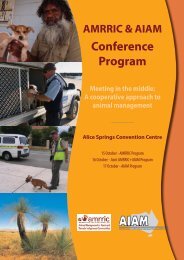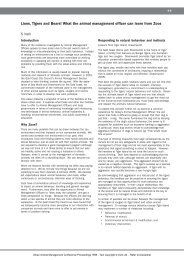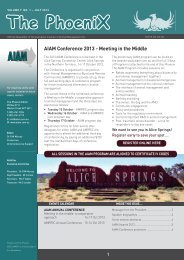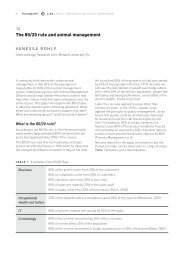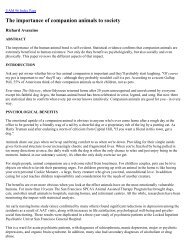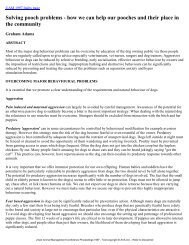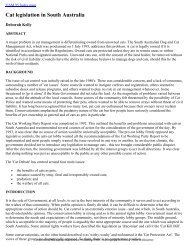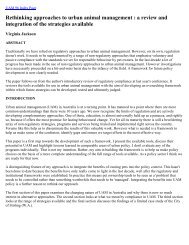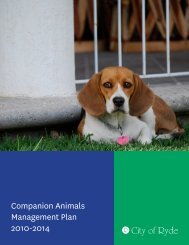Cat management for Magnetic Island - Australian Institute of Animal ...
Cat management for Magnetic Island - Australian Institute of Animal ...
Cat management for Magnetic Island - Australian Institute of Animal ...
Create successful ePaper yourself
Turn your PDF publications into a flip-book with our unique Google optimized e-Paper software.
LOOKING BACK - THE BENEFIT OF HINDSIGHTBearing in mind the benefit <strong>for</strong> Townsville City Council in being able to build on the experience <strong>of</strong> others such asVeitch (1991), Upton (1992), Wilson et al (1992), Wood (1992), Duncan (1993), Nattrass (1993), Pergl (1994), Kelly(1995), Penson (1995) and Webb (1995), this paper is in the same way intended to be <strong>of</strong> assistance to othermunicipalities that might undertake similar projects. There are a number <strong>of</strong> issues that stand out from our experience.While most people seem quite able to agree on what constitutes reasonable degrees <strong>of</strong> pet owner freedoms andconstraints with regard to cats there are those, in our experience, who find making any concessions towards the'middle ground' very difficult, if not completely impossible. Any council intending to undertake a cat <strong>management</strong>strategy should not be mistaken about this and should be prepared to deal with it.We believe that while the framework <strong>of</strong> local laws should be intended as a 'code' <strong>of</strong> reasonable and responsibleconduct it must also be en<strong>for</strong>ceable in every respect. People who harbour obsessive attitudes about cats can makethings very difficult <strong>for</strong> all the others who are prepared to sensibly agree to disagree and get on.Our experience is that the media has to be managed carefully when changes in either policy or practice <strong>of</strong> any pet<strong>management</strong> issue are in the wind. The media criticism in this case came at the point <strong>of</strong> launch when things were mostsensitive. The criticism was <strong>of</strong> an inflammatory nature and centred mainly around the allegation that the council hadincompetently handled the process <strong>of</strong> community consultation. This was a bitter pill to swallow <strong>for</strong> those who hadbeen involved since it was hard to see how the community consultation process could have been handled better(especially when the lion's share <strong>of</strong> the whole ef<strong>for</strong>t had in fact been carried out by voluntary workers).It would undoubtedly have been illuminating if the last comment could have been made by the Bush Stone Curlews <strong>of</strong><strong>Magnetic</strong> <strong>Island</strong>. Curlews are something <strong>of</strong> a 'flag carrier' native wildlife species on the <strong>Island</strong>. The most commonreason <strong>for</strong> support <strong>of</strong> a cat <strong>management</strong> plan was concern <strong>for</strong> the well being <strong>of</strong> this species (and other wildlife withless prominent pr<strong>of</strong>iles). At about the same time this plan was being put into effect, a mortality report <strong>for</strong> Curlews waspublished in the local press 4 . Of the most recent 91 recorded Curlew deaths 63 (70%) were road kills. It is intriguing towonder what the Curlews themselves would want to see happen in the interests <strong>of</strong> wildlife security. It seemsreasonable to assume that they might actually prefer, more than anything else, to see people give up their cars.REFERENCES AND OTHER READINGAllen, R.D. and Westbrook, W.H. 1979. The Pet Paradox in The Handbook <strong>of</strong> <strong>Animal</strong> Welfare - Biomedical,Psychological, and Ecological aspects <strong>of</strong> Pet Problems and Control, pp.3-13 (eds R.D. Allen and W.H. Westbrook),Garland STPM Press, New York and London.Barratt, D. 1994. Using Theory and Scientific Experience to a Assess the Impact <strong>of</strong> House-Based Domestic <strong>Cat</strong>s Feliscatus (L.) on Prey Populations and Prey Community Structure in the Proceedings <strong>of</strong> the Third National Conference onUrban <strong>Animal</strong> Management in Australia, pp. 148-156 (Ed. Paxton, D.W.), The <strong>Australian</strong> Veterinary Association, POBox 371 ARTARMON 2064, The <strong>Australian</strong> Veterinary Association, PO Box 371 ARTARMON 2064.Carr, G.M. and Macdonald, D.W. 1986. The Sociality <strong>of</strong> Solitary <strong>for</strong>agers: A Model Based on Resource Dispersion,Anim. Behav. 34: 1540.Duncan, M. 1993. The interaction <strong>of</strong> Domestic and Feral <strong>Cat</strong>s with Native Wildlife and The Warringah Council 'Role<strong>of</strong> Pets in the Community' - A Pilot Survey.Kelly, D. 1995. <strong>Cat</strong> Legislation in South Australia in the Proceedings <strong>of</strong> the Fourth National Conference on Urban<strong>Animal</strong> Management in Australia, pp. 133-139 (Ed. Paxton, D.W. and Boland, P), The <strong>Australian</strong> VeterinaryAssociation, PO Box 371 ARTARMON 2064, The <strong>Australian</strong> Veterinary Association, PO Box 371 ARTARMON2064.Liberg, O. 1984. Home Range and Territoriality in Free Ranging House <strong>Cat</strong>s Acta Zool. Fennica 17: 283.Urban <strong>Animal</strong> Management Conference Proceedings 1997 - Text copyright © AVA Ltd - Refer to Disclaimer




